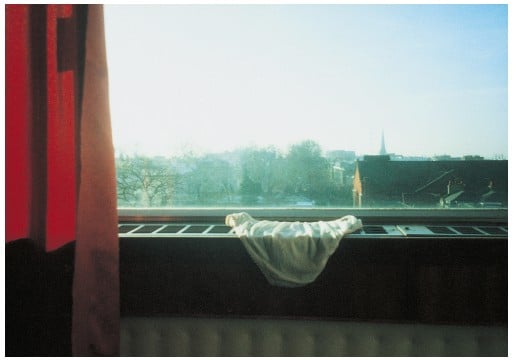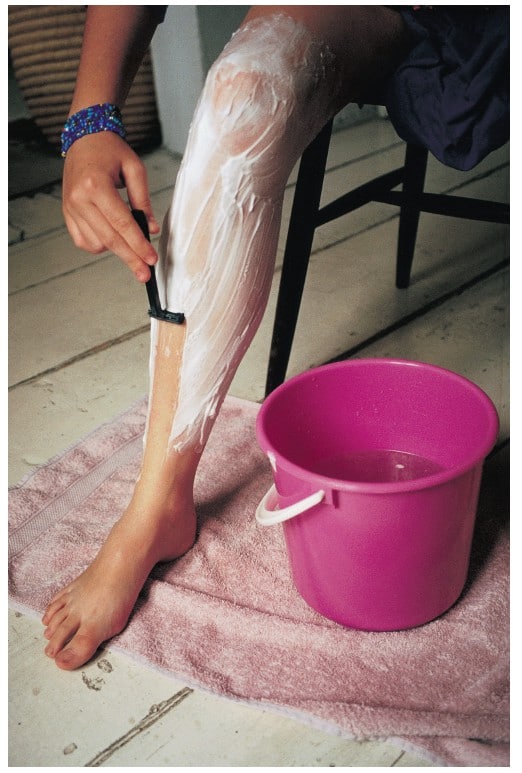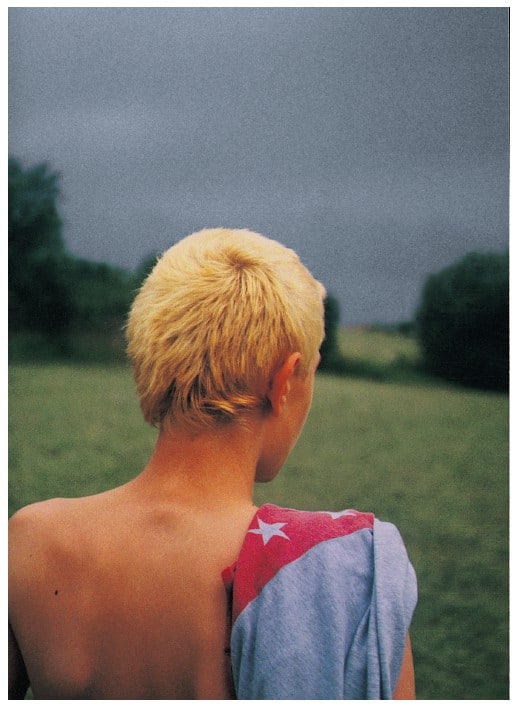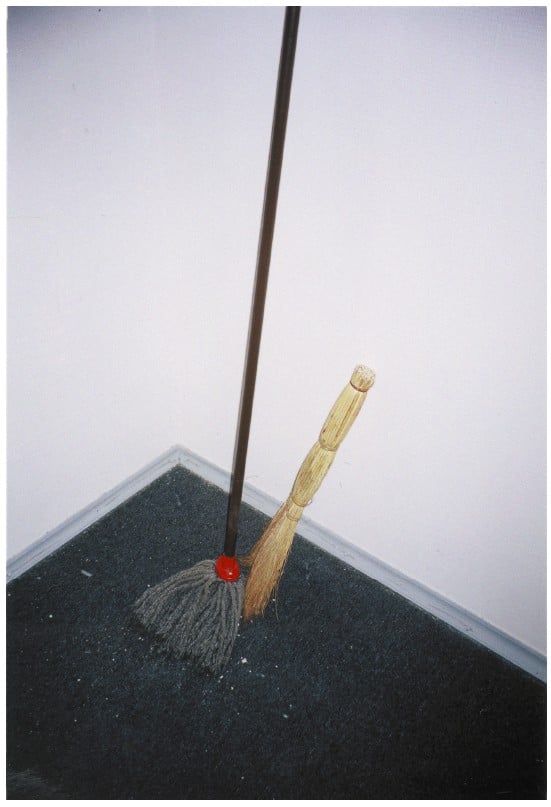Jiří David
Dissolving Signs
While in the 1980‘s (especially in the latter half) his artistic sensibility acutely reflected the tension of shifting from wild neo-expressionism towards semiotic fragmentariness, with the advent of „social washiness“ in the 1990‘s his work moved towards installation and photography. This expansion of means of expression did not take place as a result of the weakening authority of painting, nor owing to some kind of fatigue of this „slow“ medium as the general state of the Art Industry might suggest – the causes must be looked for on a much deeper level. Expanding into space, creating installations with a transitory span of existence, featuring objects in various combinations, industrial and biological ready-mades, paintings and photographs or their fragments, often accompanied by musical sound – all these were a conscious attack on the audience. It was an ambitious attempt to reach the audience with this derivation of a gesamkunstwerk of the 90‘s, to reach it with a strong emotionality, conveying a message of the social nature of the post-existentialist situation.
The subjective filter of David’s iconography combined fragments of scientific, social, artistic as well as media levels of reality. However, the artist’s interest in those did not lie in the synthethising potential of encyclopaediac romanticism; instead he was attracted by their fragmented visual quality. This seemed to offer David a look under the skin of their facticity as phenomena, supported by a conscious or suspected notion of a visible meaning of hidden structures, their interdependence or analogousness. This approach naturally led to including in individual works or more extensive installations a number of elements that bore the nature of signs, or gained symbolic forms. The intention was not, however, to arrive at some unifying conclusion; neither sign nor symbol were to David carriers of solutions, or relief (in the sense that they were in the 80‘s) – they represented to David a visually concentrated experience, a synthesis of inner variables, whose power – by a coincidence – at a certain moment manifests itself as a commonly legible cipher. The cipher would then provoke David to dissolve it in the relativization of meaning in a work of art, where a crucial feature was the movement on the edge of contemporary notions of aesthetics. David s intention in such a work was to positively upset and subvert the stupefying tendency of the cultural and social context.
This peculiar nature of sign and symbol continues to attract David, as is evidenced by his monumental iridescent neon objects realized in Prague in recent years (the crown of thorns suspended over the art gallery and concert hall Rudolfinum, entitled Shine – object sized 15 x 11 x 5 metres, in blue neon, 2001; or the red heart placed over Prague Castle, symbol of the Czech state and seat of the President, entitled Heart at the Castle, an object sized 13 by 13 metres, in red neon, 2002). David uses elements akin to signs or symbols. As the philosopher of law Jiří Přibáň wrote in the newspaper Pravo‘s culture supplement, this nature of his material is to David the use of an unusual language, where difference dominates instead of representation, a difference that provokes instability in the inner structure of the work and its message (Salón, Právo‘s supplement of 12 December 2002, page 4, Prague, ). In short, sign and symbol function for David as a pretext for an emotionally exalted reference to the visual sources of his imagination and their neurotically interconnected, mutually attractive or repulsive links. The legibility of sign or symbol in David’s work is always dependent on the context, even when the work consists of the sign itself.
However, Jiří David does not limit himself to the mere compactly fragmented artefact, intricately – all too intricately for the taste of many – exploiting the well-tried formulas of visual narration. Since the advent of the excited, postmodern sensibility of the 80’s he has been as intensely drawn by the direct striking power and concentration of a work of art. This fascination with apparent, delusive simplicity where each universally understandable visual reading carries within itself a potentiality of other layers of meaning together with an instant emotional impact has its origin in David’s interest in film and photography. The rapidity, instantaneousness, but also instability, full of palpitating excitement that attracted David to photography first appeared in his work at the beginning of the 90’s, in his confident assault on the media, without any kind of stylistic or genre prejudices. It was as though David sensed the untapped potential of this friendly medium, with the visual density of its direct message, dissolving in it the traditional fragmentary signs of his paintings and installations, letting himself be carried off by the force of the photographic “full image”. Photography merged into David’s aesthetic producing one indivisible whole, and its feedback was soon reflected in all other areas of his activity, leading him to think about the complexity of capturing the emotional, aesthetic, existential as well as realistic experience in one work, in a single instant, in a single stroke (his painted images show this tendency in his series of mountain landscapes, begun in 1990, as well as in the last abstract series of 2003, exhibited under the title Being Conscious). In David’s conception, however, the work of art always retains the capacity to dissolve the aesthetic and social routines and cliches, searching for the visual qualities and otherness of the given context, thus retaining the power of re-evaluating signs and symbols that are so often worn thin by the cliched media or by political usage, or inflated by the current art industry.
If we survey David’s photographic work, we find next to pointed “simple” works also series that work with a visual narration close to the “vintage” David paintings and installations. They apply the play of signs in their primary as well as in their iconographically more tricky connotations. In this respect, the most characteristic is the series My Hostages of 1998 that focuses on child violence and manipulation (the series was exhibited in the same year in Prague and in the Anita Neugebauer Galery in Basel). An even greater international recognition, however, came as the result of applying in his photography an “uncomplicated” mode of creative work based on a crystal clear idea, such as we may find in Hidden Likenesses of 1991 to 1995, or in the series of weeping politicians entitled Without Compassion (2002). The first series consists of pairs of black and white portraits of various luminaries – artists, scientists, politicians or sportsmen. The en-face shots were split in the middle and each face in the pair is made of two mirror left sides of the face and two right sides of the face. Examination of the face as a sign, as a visible bearer of biological-psychological givens appearing as the exclusive individuality, was commented on by Jacques Derrida, one of the people portrayed, as a possible means to discovering “another I myself, twice I, an I that knows itself without recognizing itself”. David allows the face, the fragment of a personality, to use its natural asymetrical qualities, in order to – by means of “artificial” symmetry – reconstruct hidden yet determining bonds. Five years of work on the series resulted in more than a hundred “portraits”, which however in no way diminishes the impact of each individual pair – each right/right and left/left pair of faces remains both visually and mentally powerful. A similar effect is achieved with David’s politically correct and diplomatically presentable (even to the degree of iconic symbolism) portraits of world politicians or statesmen, be they positive figures like the Dalai Lama, the Pope or Václav Havel, controversial ones (Vladimir Putin, George W. Bush), or plainly negative ones (Fidel Castro, Yasir Arafat, Bin Laden). The series Without Compassion would simply manipulate a ready-made photograph, available in any press agency. David would introduce a simple emotional sign – his own tears – without distinction into all the chosen political figures. His intention was not merely to draw attention to the out-of-place attribute of weeping. This surprising element puts in question the visible (un)reality and experience. Both series went through a number of solo as well as collective shows – Hidden Likenesses appeared in Rudolfinum in Prague, in the Jack Tilton Gallery in New York, and at the Venice Biennale in 1995, in the following year the travelled to Zamek Ujazdowski in Warsaw, and later to Chicago (1998), to Musee de L Elysee in Lausanne (1999). Without Compassion opened in Václav ·pála Galery in Prague in 2002, and subsequently travelled to the Projektraum Gallery in Vienna. Its portfolio was published by European Photography (vol. 71), in 2003 it was shown in the Neune Galerie in Graz (Austria), at the Mois de la Photo in Montreal, in Moscow, and at the Face exhibition in Lisbon, organized by the Musee de l Elysee of Lausanne.
Apart from series of conceptual photographs, David has been since approximately the middle 90’s working ever more intensely with the camera itself, generating several series in a seemingly infinite loop. Its results were published in a monograph David-David by the Prague publishing house Kant in 2002. Color photographs balancing on the edge between a staged concept and an accidental, documentary shot, together with a colour and light composition similar to that of painting allowed David to make visible his intimate relationship to immediate reality, and to strike off subtle visual-narrative games with a number of possible subtexts. A series entitled Daniel (begun in 1995) is especially suggestive, capturing as it does the growing up of David’s son. The family model is strikingly photogenic and pliable, the “infinite” time making it possible to work in suitable lighting, mood and environment. David’s “painterly” experience in working with colour, space and props brought a peculiar result, where both the individual photographs and the series as a whole can acquire the nature of symbolic representation, without it having been primarily intended. In Daniel, David combines his experience with fragmentary narration and working with signs and symbolic meanings in an attractive and easily comprehensible way that clearly functions because of its directness, and yet retains the possibility of very layered perception.
Perhaps as a dynamic counter-balance, David is also fascinated by the complexity of the photographic image with its virtual computer existence, as is explicitly demonstrated in Silver People. Here David indulges in the use of symbolic props (lamb) or incriminating details (male and female genitals in Adam and Eve) in a freshly provocative way that avoids the cliches one might justifiably fear. David s approach reveals the mastery of experience in dealing with the precarious cargo of connotations in various signs and symbols. He is guarded by a justified assumption of their timelessness as well as facticity – using them in a surprising way at a time when for many they represent mere worn out padding. That is precisely the condition that excites David. He also likes to feature in his works (not only this photographs) the mask – besides the aforementioned series My Hostages a mask is found in One Day (2001), where his son Daniel is concealed under a balaclava. However, rather than a sign carrying a certain meaning, the mask represents to David a questioning of identity, or an aesthetically provocative play of relativizing perception.
The effectiveness of precisely accentuated impropriety, behind which we sense both biological and symbolic determination dissolved in compact paintings and photographs, is a constant one should expect to meet with in Jiří David in the future. The jigsaw puzzle of his imagination is made of simple as well as complex structures of visuality that conceal our desire to glimpse in a felicitous harmony both emotions and reason, to glimpse them in the dangerous wafts of an ever changing Davidian aesthetic.
#3 Transforming of Symbols
Archive
- #45 hypertension
- #44 empathy
- #43 collecting
- #42 food
- #41 postdigital photography
- #40 earthlings
- #39 delight, pain
- #38 death, when you think about it
- #37 uneven ground
- #36 new utopias
- #35 living with humans
- #34 archaeology of euphoria
- #33 investigation
- #32 Non-work
- #31 Body
- #30 Eye In The Sky
- #29 Contemplation
- #28 Cultura / Natura
- #27 Cars
- #26 Documentary Strategies
- #25 Popular Music
- #24 Seeing Is Believing
- #23 Artificial Worlds
- #22 Image and Text
- #21 On Photography
- #20 Public Art
- #19 Film
- #18 80'
- #17 Amateur Photography
- #16 Photography and Painting
- #15 Prague
- #14 Commerce
- #13 Family
- #12 Reconstruction
- #11 Performance
- #10 Eroticon
- #9 Architecture
- #8 Landscape
- #7 New Staged Photography
- #6 The Recycle Image
- #5 Borders Of Documentary
- #4 Intimacy
- #3 Transforming Of Symbol
- #2 Collective Authorship
- #1 Face











